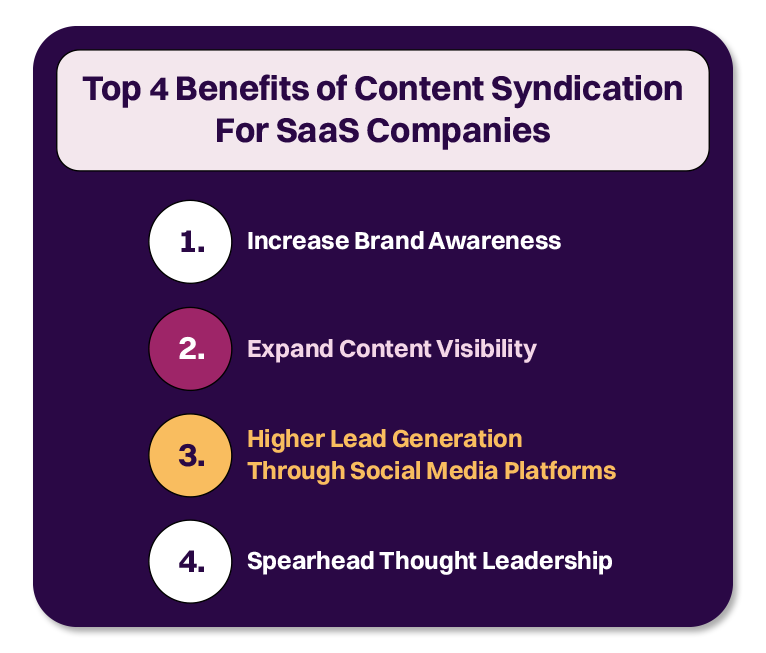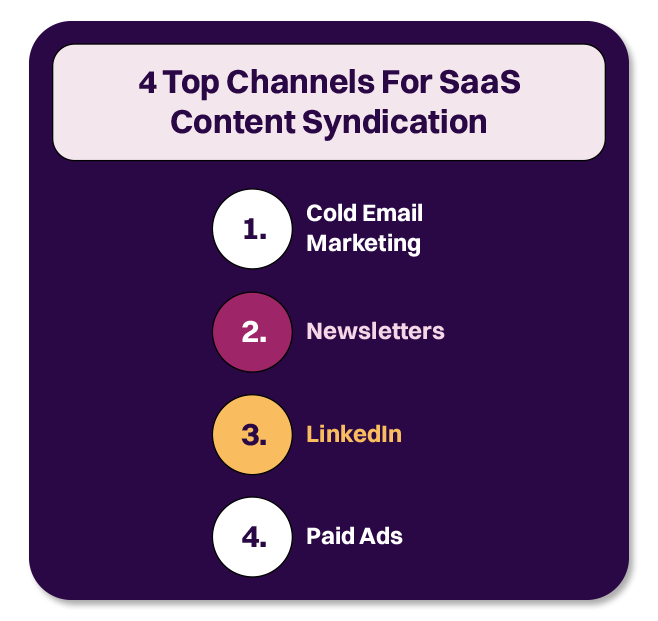
How SaaS Companies Can Reduce Their CAC With Content Syndication
Let us throw a question your way: What do top SaaS companies have in common?
Well, they have an amazing ability to acquire more and more users over time!
In fact, user acquisition is the lifeblood of any SaaS company. Once you create your product, you need to get the word out. To do so, content marketing is a chosen marketing path that any business can swear on.
There are multiple ways you can leverage content marketing. But, to stand out in the SaaS industry, we suggest you go for content syndication. It can be the trusty steed to help you reach your high-value SaaS leads while reducing the customer acquisition cost (CAC)!
But wait, don't just take our word for it! Statistics say that over 79% of B2B businesses are actively involved with content syndication vendors.
So, let’s dive headfirst into how content syndication works for SaaS companies. The blog post will also share benefits, effective syndication channels, and strategies for the same.
But first, understand the diverse target audience you’ll be pursuing as a marketer for your SaaS business.
Overview of Different SaaS Decision-makers
Remember, the SaaS industry is a bit like a dinner party – there are various guests with unique tastes, and you want to cater to all of them. So, allow us to introduce your top SaaS decision-makers to target as per your offering.
1. The CTO (Chief Technology Officer)
- Designation: As the tech guru, the CTO plays a pivotal role in technology decisions.
- Characteristics: They are highly technical, visionary, and often deeply involved in product selection and implementation.
2. The CFO (Chief Financial Officer)
- Designation: The money maestro, the CFO, holds the purse strings and ensures financial feasibility.
- Characteristics: They are financially savvy, focused on Return on investment (ROI), and often concerned with CAC.
3. The CMO (Chief Marketing Officer)
- Designation: The marketing maestro, the CMO, is all about driving growth and SaaS customer acquisition.
- Characteristics: They are results-driven, marketing-savvy, and keen on solutions that improve customer engagement.
4. The Head of IT
- Designation: Often responsible for the day-to-day IT operations and vendor management.
- Characteristics: They need practical, efficient solutions and often look for scalability and integration capabilities.
5. The End User
- Designation: The employees who will actually use your SaaS product.
- Characteristics: They want user-friendly, intuitive software that makes their work easier and more efficient.
Next, you need to define your ideal customer profile (ICP) and create buyer personas to cater to this diverse audience.
But first, let’s see the differences between these two segments to avoid confusion:
Ideal Customer Profile Vs Buyer Persona
| Ideal Customer Profile | Buyer Persona |
| A generalized description of the ideal company | Detailed representation of a fictional individual |
| Targets organizations or businesses | Targets individual customers |
| Emphasizes company size, industry, and goals | Includes demographics, pain points, and goals |
| Guides targeting and marketing to specific firms | Helps in tailoring product to individual needs |
| Assists in targeting organizations for B2B sales | Aids in understanding individual purchasing behavior |
Moving ahead, let’s:
Define The Ideal Customer Profile (ICP)
Follow these steps:
- Define Criteria for Ideal Company: It requires you to learn about your business and what solutions and support you can offer. Then, define generalized ICP criteria (Industry, Company size, Geo-location, etc) for the companies you want to serve.
For example, you may want a Los Angeles-based client business with a 10-20 employee count in the SaaS industry. So, this would be your ICP criteria.
- Segment Your Market: Divide your target market into different categories based on:
- Industry
- Company size
- Geography,
- Goals and more.
It will help you pick companies that fit in the above categories as per your pre-defined criteria.
- Pick Customized Marketing Campaign: Create a customized marketing campaign for your target group of businesses. Analyze their unique needs and preferences. Further, tailor content, channels, and messaging to resonate with these organizations. It will ensure relevance and engagement.
Further, if you want to target particular individuals within your target businesses, then you must define buyer personas.
Create Buyer Personas
Follow these steps:
- Create Fictional Buyer Characters: Develop each character based on market research, customer data, and insights gathered from your existing customer base. A Focus on key demographic information such as:
- Age
- Gender
- Location
- Education
- Income
- Occupation
It’ll help you build foundation for understanding who your target customer is and where they come from.
Further, assign names, job titles, and even stock photos to your buyer personas. It makes them more relatable.
- Map Individual Buyer Personas Jorney: Focus your marketing and sales efforts on addressing the specific needs, preferences, and behaviors of these personas. It allows for a more personalized and effective approach.
- Understand Goals and Challenges: Define what each persona is trying to achieve with your SaaS product and the pain points they face.
- Tailor Content and Messaging: Customize your marketing content to fulfill the specific needs, desires, and pain points of your personas. You can tailor your offerings to better meet individual requirements.
- Iterate and Update: Learn your buyer personas:
- Buying motivations
- The channels they prefer for research and purchase
- The factors influencing their decision-making process
Top 4 Benefits of Content Syndication for SaaS Companies

Check out what all your SaaS business can gain with a content syndication campaign.
1. Increase Brand Awareness
Content syndication can boost brand awareness around your SaaS business.
How?
Imagine you're a SaaS company specializing in project management software. Here, you can use paid syndication services to publish your insightful blog posts on prominent websites and landing pages.
Readers who find value in your content will begin associating your brand with expertise in project management. Thus, it'll increase your brand awareness.
This way, you can expose your brand to potential audiences. However, be sure to choose 3rd- party platforms whose reader base matches your ICP.
2. Expand Content Visibility
It's the by-product of increasing brand awareness through content syndication. But this tactic brings more to the table when it comes to boosting your content's visibility.
Consider a scenario where you create a video tutorial showcasing using your SaaS tool effectively. By sharing this video link on channels like cold email, LinkedIn posts, newsletters, etc, your content quickly reaches your target audience.
3. Higher Lead Generation Through Social Media Platforms
Let's say you syndicate an engaging infographic about industry trends on LinkedIn. This content, when shared and reshared by your network and industry influencers, can capture the attention of decision-makers at various companies. They might be compelled to connect with your company, turning into valuable leads.
For example, a VP of Operations at a growing tech startup might see your infographic, like it, and request a connection. Thus, content syndication opens the door for potential business opportunities.
4. Spearhead Thought Leadership
Content syndication allows you to position your SaaS business as thought leaders. Let's say you write a comprehensive whitepaper on the future of cloud computing. By syndicating this whitepaper on renowned 3rd party platforms, you can become a catalyst for discussions.
Also, other industry experts, readers, and potential customers will start assuming you are an authority in the field.
It elevates your status as a SaaS solution provider.
Choose High-Quality SaaS Content for Syndication
Undoubtedly, high-quality content is the cornerstone of your successful SaaS content syndication. It directly serves as a driver of:
- Increased brand authority
- Audience engagement
- Quality lead generation
- Established credibility
Moreover, the below statistics also show the importance of high-quality content:
- 44% of people believe that making their content better helped them succeed.
- 53% are working on making their content better.
- 37% are putting research-focused content first.
Now, let's explore the types of high-quality SaaS content suitable for syndication:
1. Thought-Leadership Articles
Thought-provoking articles that offer unique insights into:
- Industry trends
- Best practices
- Future predictions
-can be syndicated to showcase your expertise.
For instance, you might write an article on "The Evolving Landscape of AI in SaaS," sharing your visionary perspective.
2. Whitepapers
With whitepapers, you can present in-depth reports that dive deep into a specific topic. Syndicating such content can position your company as a thought leader within the SaaS industry.
3. Case Studies
Real-world success stories are compelling, aren't they? A case study showcases how your SaaS solution helped a customer achieve remarkable results. Thus, you can use case studies to show your product's practical benefits.
4. Infographics
This content type is visually appealing and easy for your audience to consume. You can create infographics summarizing complex concepts or data to share widely.
5. Video Demos
Today, video content is increasingly popular. 91% of consumers want brands to make more online video content.
A video demo illustrating how your SaaS product solves a common problem can captivate and educate your audience.
6. EBooks
These can serve as valuable resources that your high-quality leads would love. Syndicating an eBook relevant to your audience's interest can draw in leads seeking comprehensive information.
Select the Right Syndication Channels

Right syndication channels help you effectively reach your target audience. Each channel has its unique strengths and use cases.
So, let's explore these channels:
1. Cold Email Marketing
Here, you send emails to a list of potential leads or customers unaware of your brand. It works as a powerful syndication channel when used strategically.
If your SaaS company launches a new product, cold emailing can be a great syndicating channel. You could send personalized emails to a carefully curated list of prospects who might benefit from your solution. These emails can include links to your syndicated content, such as a whitepaper or a thought-leadership article.
Further, you can add recipients to your subscriber list once they fill out the lead form to access your content link.
The key here is personalization and relevance. When done right, SaaS cold email marketing opens doors to meaningful conversations and drives high-quality leads.
2. Newsletters
If you want your subscribers to stay informed about your desired content, newsletters are the best way to syndicate it.
You can regularly send out a newsletter to your subscribers featuring snippets and links to your recently syndicated articles, infographics, or case studies. This channel is perfect for nurturing relationships and maintaining an engaged readership. Plus, it encourages repeat visits to your website or content platform.
3. LinkedIn
Let us tell you LinkedIn is the most dynamic platform for your B2B content syndication. It's a goldmine for connecting with professionals. You can share your thought leadership articles, infographics, or video demos on your LinkedIn company page, as well as in relevant groups or discussions.
Plus, you can engage with your audience in the comments and encourage discussions. It boosts the reach and impact of your syndicated content.
4. Paid Ads
Paid advertising on business-oriented social media platforms works wonders. You can specifically use LinkedIn for SaaS leads as it amplifies the visibility of your syndicated content to your filtered target profiles.
In fact, you can run paid video ads on these platforms to target specific demographics. Plus, paid ads are highly customizable, allowing you to reach your ideal audience quickly.
9 Best Content Syndication Strategy for SaaS Company
Finally, you reached the section where we'll tell you the best syndication strategies for SaaS. Let's explore:
1. Create Gated Content
Create content like eBooks, webinars, or in-depth guides that provide valuable insights and information about your SaaS product. Now, think of "gating" this content, which means asking users for their contact information (like email) before they can access it. This strategy helps you in two ways:
- You get to share your knowledge and expertise, showing potential customers that you really know your stuff.
- You also build a list of people interested in your SaaS product, which can be a valuable resource for future marketing.
2. Set Outreach Goals and metrics
You need to know where you're going (your goal) and how you'll know you're on the right track.
As your goal is to generate quality SaaS leads for the sales pipeline, you must focus on relevant outreach metrics.
You can measure metrics like:
- Number of sign-ups
- Demo requests
- Lead quality
- Lead volume
- ROI
- Conversions
By keeping track of these, you can adjust your strategy to make sure you're heading in the right direction.
3. Connect With the Right Vendor
When you're a SaaS company, connecting with the right vendor means finding a partner who can help you reach your goals.
Your vendor might be a company specializing in content distribution or marketing services.
The funny thing is that each vendor will tell you how their syndication process is THE BEST. But, of course, no random syndicating approach can work wonders for your company.
For SaaS, we recommend a more sophisticated syndication process, such as:
- Vendors must let you choose the content type you want to syndicate.
- Then, you should be able to decide whether you want to target contacts or accounts.
- Keeping your target audience in mind, your vendor should pick the best syndicating channels.
- Lastly, you should get a list of highly-interested leads based on their actions toward your syndicated channel.
It'll help you find and nurture only high-potential leads.
4. Establish Filters (While Segmenting Email Lists )
When we talk about "establishing filters," it's like organizing your email list into different categories or groups. And each group shares similar interests or characteristics.
It helps you send the right content to the right people. To effectively add filters, use the following criteria:
- Demographics: Age, gender, location, job title, etc.
- Behavior: Past purchases, email engagement (opens, clicks), website visits, and more.
- Preferences: Content interests, product interests, communication preferences
Further, you can use email marketing platforms like Mailchimp, Constant Contact, or HubSpot that have built-in tools for list segmentation.
Pro tip- Your email list isn't static. Subscribers' behaviors and preferences change over time. So, regularly review and update your segments.
5. Craft Personalized Outreach Content for Syndicating Channels
When you're sending emails or messages to people, it's important to make them feel like you're talking directly to them.
Instead of sending a generic message to everyone, start doing custom prospect outreach. Use their name in the message, and talk about things that matter to them, like their interests and needs. It shows you care and aren't just sending mass emails.
6. Choose the Best Timing and Frequency for Outreach
Timing is crucial, like when you plan to call a friend. You wouldn't call them super early in the morning or really late at night, right? Timing matters.
Consider when your audience is most likely to check their emails or be active on social media. This is when you should share your syndicated content. For example, if your audience is mostly online in the afternoon, share your content then.
Frequency is how often you reach out. It's like deciding how many times you'd call your friend weekly. You don't want to bug them with too many calls, but you also don't want to be a stranger. Find the right balance so your audience gets your content regularly but not too often.
7. Nurture Your Content Syndication Leads
Let’s see how to nurture the leads you gain from your syndication efforts:
- Prepare Some Good Stuff: Before passing potential customers to the sales team, have some basic follow-up content ready to keep them interested. We call this "lead nurturing."
- Learn More About Them: When your content syndication leads get your follow-up emails, pay attention to how they react. It tells you what they need at the moment.
- Sort and Personalize: Based on what you learn, send them content they like. It makes them feel special.
- Give Points: Create a system to give points to people based on their interactions with your outreach efforts. For example, if they look at the price page, they get high points.
- Pass to Sales: When people gather enough points, making them promising sales opportunities for you, send them to the sales team.
8. Perform Data Enrichment
Some relevant data may expire between generating a new lead from your syndication efforts and turning them into paying customers. Plus, B2B data expires at a monthly rate of 2.1%.
Thus, in this case, you need to perform data enrichment. It’ll remove unresponsive leads and update expired contact information. Here are simple ways to do so:
- Identify the Silent Leads: First, figure out which leads haven't been responding to your emails or nurturing attempts. These are the ones you want to remove.
- Keep the Active Ones: Focus on keeping the leads that are engaging with your content or showing interest in your products or services. These are the ones you want to nurture further.
- Update Your Database to Nurture: Make sure to update your lead database after identifying promising leads and cross-checking if the contact information is correct. It keeps your list clean and efficient. Plus, you only invest in nurturing the updated lead list.
9. Measure Success And Optimize
Who does not want to know whether their efforts are bringing results?
So, don't be behind when it comes to measuring your content syndication outcome. Your metrics should reflect the same as your focus on generating leads for your SaaS business.
Measure the following:
- Lead Generation: Measure how many new leads you're getting from syndicated content.
- Lead Volume: Select a specific time frame and measure the number of new leads your content syndication campaign generates in that duration.
- Conversion: Track the percentage of leads that become customers.
- Lead Quality: See how many high-quality leads you get compared to unfit leads.
Based on your analysis, you need to optimize your content syndication campaign. A great way to do so is A/B testing. It'll help you focus on syndicating more of the content that generates the most leads and conversions.
Conclusion
Content syndication is undoubtedly an amazing tactic for SaaS companies looking to boost user acquisition with less CAC. By sharing your valuable content across 3rd-party distribution channels, you significantly bring in more fitting leads.
However, you need a reliable and professional partner to reap the benefits of a content syndication strategy truly. This is where Revnew comes in.
We are your go-to content syndication agency if you’re a SaaS company. We understand the unique needs of the SaaS audience. Our expertise is content promotion, targeting the right audience, and ensuring your content aligns perfectly with your branding and objectives. It makes us the ideal choice for your content syndication needs.
So, get in touch with us today to take your SaaS user acquisition to the next level!




